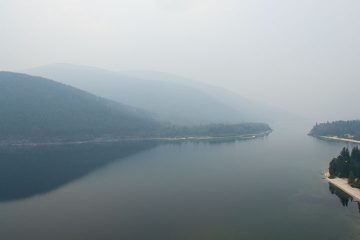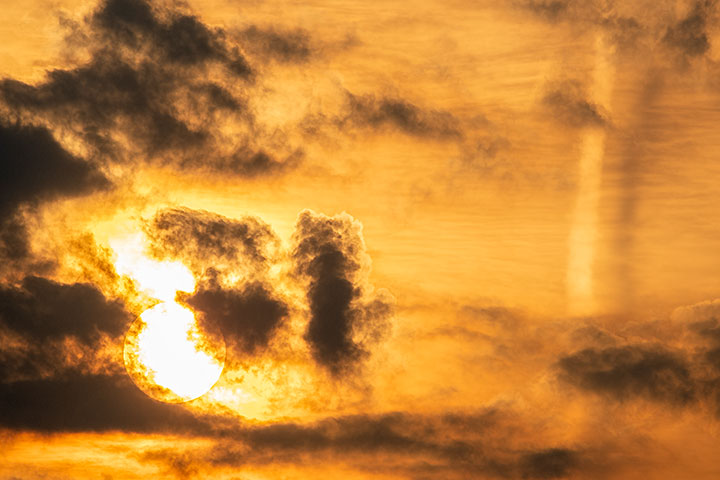Down here on the surface of the earth, we are used to judging distance with the help of contrast: distant objects have a lower contrast than those in the foreground. This insight works for solid objects with sharp boundaries. So, with each successively distant ridge, the trees lose contrast as dark objects become lighter and bright objects become darker.

This is so much a part of our experience that we don’t give it any thought while using it to judge relative distance. It is illustrated with a picture taken through the smoky air of last summer’s fire season (right), but the behaviour is the same, only more gradual, in clear air.
The guideline that contrast decreases with distance can be problematic when dealing with clouds, which range from the opaque to the diaphanous. Consider this morning’s sunrise shot. (The yellowish cast results from the smoke of forest fires farther east, and while the colour adds to the drama, it is not the point of this discussion.)
Rather, look at the contrail on the right side of the picture. We percieve it as being in front of the higher cloud because of its higher contrast. Alas, our perception is wrong.
Consider the geometry of the scene. The sun is above the horizon and so must be shining down on all clouds. However, the contrail is casting a shadow on that supposed higher cloud. Ergo, despite perceptions, the contrail must be above (more distant than) the high cloud.
A contrail (right-hand side) looks as if it is lower than the high cloud, but it is actually higher.


Perplexing sky
Down here on the surface of the earth, we are used to judging distance with the help of contrast: distant objects have a lower contrast than those in the foreground. This insight works for solid objects with sharp boundaries. So, with each successively distant ridge, the trees lose contrast as dark objects become lighter and bright objects become darker.
This is so much a part of our experience that we don’t give it any thought while using it to judge relative distance. It is illustrated with a picture taken through the smoky air of last summer’s fire season (right), but the behaviour is the same, only more gradual, in clear air.
The guideline that contrast decreases with distance can be problematic when dealing with clouds, which range from the opaque to the diaphanous. Consider this morning’s sunrise shot. (The yellowish cast results from the smoke of forest fires farther east, and while the colour adds to the drama, it is not the point of this discussion.)
Rather, look at the contrail on the right side of the picture. We percieve it as being in front of the higher cloud because of its higher contrast. Alas, our perception is wrong.
Consider the geometry of the scene. The sun is above the horizon and so must be shining down on all clouds. However, the contrail is casting a shadow on that supposed higher cloud. Ergo, despite perceptions, the contrail must be above (more distant than) the high cloud.
A contrail (right-hand side) looks as if it is lower than the high cloud, but it is actually higher.
